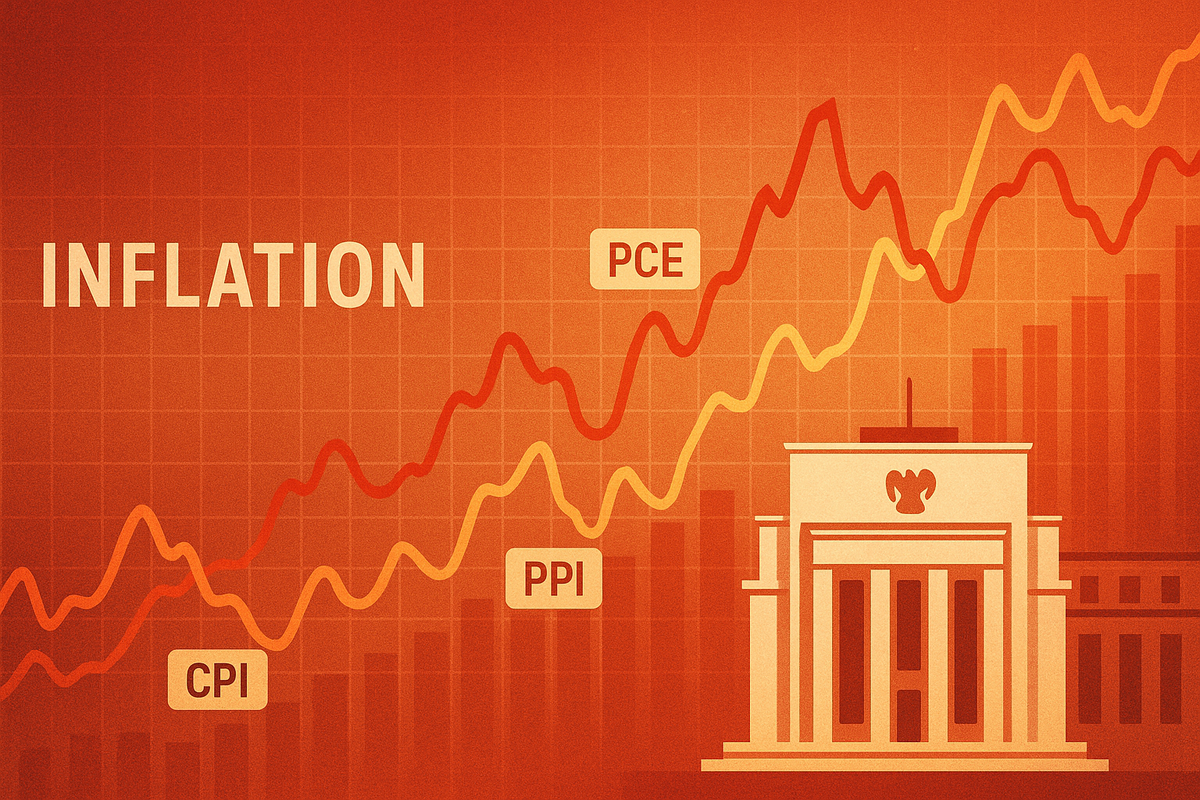
The specter of persistent inflation continues to loom large over the U.S. economy, as the latest data for the Consumer Price Index (CPI), Personal Consumption Expenditures (PCE) price index, and Producer Price Index (PPI) all indicate that price pressures remain stubbornly above the Federal Reserve's long-sought 2% target. This sustained inflationary environment is raising significant concerns for policymakers, businesses, and consumers alike, suggesting that the path to price stability may be longer and more arduous than previously anticipated.
The confluence of these key economic indicators paints a challenging picture for the Federal Reserve, which is tasked with balancing its dual mandate of maximum employment and price stability. The continued elevation of inflation metrics, particularly at the producer level, complicates the central bank's monetary policy decisions and casts a shadow over the prospects for interest rate adjustments in the near future.
Inflation's Unyielding Ascent: A Deep Dive into the Data
The latest inflation figures for July 2025 have sent a clear message: inflationary pressures are broad-based and deeply entrenched. The Consumer Price Index (CPI) for All Urban Consumers (CPI-U) saw a modest 0.2% increase month-over-month on a seasonally adjusted basis. However, the unadjusted all-items index rose 2.7% over the 12 months ending in July, holding steady from the previous month. More concerning was the core CPI, which strips out volatile food and energy prices, climbing 0.3% month-over-month and a significant 3.1% year-over-year. This marks a five-month high for core CPI, indicating that underlying price pressures are not abating. Key drivers included shelter, medical care, airline fares, and used cars and trucks.
The Personal Consumption Expenditures (PCE) price index, the Federal Reserve's preferred inflation gauge, also reflected elevated prices. For June 2025 (the latest available data), the headline PCE Price Index increased by 2.6% year-over-year, up from 2.4% in May. The core PCE Price Index, excluding food and energy, rose 2.8% year-over-year. These figures, while slightly lower than CPI, still comfortably exceed the Fed's 2% target, underscoring the pervasive nature of inflation across the economy. The upcoming July PCE data, scheduled for release on August 29, 2025, will be crucial in shaping the Fed's immediate policy outlook.
Perhaps the most striking data point came from the Producer Price Index (PPI) for final demand, which surged by an unexpected 0.9% month-over-month in July 2025, significantly surpassing expectations of a 0.2% increase. This marks the largest monthly jump since June 2022. On an unadjusted basis, the headline PPI advanced 3.3% for the 12 months ended in July, following a 2.4% increase in June. The core PPI, excluding food and energy, also rose sharply, increasing 0.9% month-over-month and 3.7% year-over-year. This wholesale inflation, driven by a 1.1% rise in final demand services prices (particularly machinery and equipment wholesaling margins, trade services, and freight transportation) and a 0.7% climb in goods prices (including a 38.9% surge in fresh vegetables and an 11.8% jump in diesel fuel), signals that businesses are facing escalating input costs, which are likely to be passed on to consumers, perpetuating the inflationary cycle.
The timeline leading up to this moment has been characterized by a series of aggressive interest rate hikes by the Federal Reserve starting in early 2022, aimed at cooling an overheating economy and bringing inflation under control. While these measures initially showed signs of moderating price increases, the latest data suggests that the battle is far from over. Key players involved include the Federal Reserve's Federal Open Market Committee (FOMC), the U.S. Department of Labor (which releases CPI and PPI data), and the Bureau of Economic Analysis (which releases PCE data). Initial market reactions to the hotter-than-expected PPI data included a reduction in the probability of a September interest rate cut, with some analysts even speculating about the possibility of further tightening if inflation does not show a clear downward trend.
The Shifting Sands: Winners and Losers in an Inflationary Environment
The persistence of high inflation creates a complex landscape where certain sectors and companies may find themselves in advantageous positions, while others face significant headwinds. Companies with strong pricing power and those that can effectively pass on increased costs to consumers are likely to be the "winners" in this environment. Conversely, businesses with thin margins, high input costs, or those operating in highly competitive markets may struggle to absorb rising expenses, making them potential "losers."
Companies in the energy sector, such as ExxonMobil (NYSE: XOM) and Chevron (NYSE: CVX), often benefit from higher commodity prices, which contribute to inflationary pressures. As the cost of crude oil and natural gas rises, these companies can command higher prices for their products, leading to increased revenues and profits. Similarly, mining companies and agricultural firms that produce raw materials may see their revenues boosted by rising commodity prices. For instance, a surge in fresh vegetable prices, as noted in the PPI data, could benefit large agricultural producers.
On the other hand, consumer discretionary companies and retailers with limited pricing power, such as Target (NYSE: TGT) or Macy's (NYSE: M), could face significant challenges. As consumers' purchasing power is eroded by inflation, they may cut back on non-essential spending. These companies also face the dual challenge of rising input costs (from the PPI data) and potentially stagnant consumer demand, squeezing their profit margins. Similarly, airlines like Delta Air Lines (NYSE: DAL), while seeing some price increases, are highly susceptible to fluctuating fuel costs, which can quickly erode profitability if not managed effectively.
Furthermore, companies reliant on imported goods or those with complex global supply chains may experience increased costs due to tariffs and higher shipping expenses, which contribute to inflationary pressures. Manufacturers that cannot easily substitute expensive raw materials or labor will also struggle. Conversely, companies providing essential services like healthcare providers (e.g., UnitedHealth Group (NYSE: UNH)) or utilities (e.g., NextEra Energy (NYSE: NEE)) may be more resilient, as demand for their services tends to be less elastic, allowing them to potentially pass on some cost increases. Financial institutions, particularly banks, might see increased net interest margins if interest rates remain elevated, but they also face the risk of increased loan defaults if economic growth slows significantly.
Broader Implications: Industry Shifts and Policy Crossroads
The sustained inflationary environment is not merely a statistical anomaly; it represents a significant economic force with far-reaching implications for various industries and the broader regulatory landscape. This persistent inflation fits into a broader trend of supply chain disruptions, geopolitical tensions, and robust consumer demand that has characterized the post-pandemic economy. The current situation suggests that the "transitory" narrative of inflation has been definitively put to rest, replaced by a more entrenched and structural challenge.
The ripple effects of persistent inflation are evident across multiple sectors. For instance, the manufacturing sector faces continued pressure from rising raw material costs and labor expenses, as indicated by the surging PPI. This could lead to higher prices for manufactured goods, impacting downstream industries and ultimately consumers. The construction industry is also vulnerable, with increased costs for building materials and labor potentially slowing new projects and exacerbating housing affordability issues. The transportation and logistics sector will continue to grapple with elevated fuel prices and labor shortages, which contribute to higher freight costs and further fuel inflation.
From a regulatory and policy perspective, the Federal Reserve is at a critical juncture. The persistent inflation data, particularly the strong core CPI and PPI figures, puts immense pressure on the central bank to maintain its hawkish stance. This could mean higher interest rates for longer, or even the possibility of further rate hikes if inflation does not show a clear and sustained trend towards the 2% target. Such a scenario would have significant implications for government borrowing costs, the national debt, and the overall fiscal health of the nation. Historically, periods of high inflation have often led to more stringent monetary policies, sometimes at the risk of economic slowdowns or recessions. Comparisons can be drawn to the late 1970s and early 1980s, when the Fed, under Paul Volcker, aggressively raised interest rates to combat runaway inflation, albeit with significant economic pain.
Moreover, the role of tariffs in contributing to inflationary pressures cannot be overlooked. While not explicitly detailed in the initial research, tariffs on imported goods can increase the cost of inputs for domestic producers, who then pass these costs on to consumers. This protectionist policy, while intended to support domestic industries, can inadvertently fuel inflation by reducing competition and increasing the price of goods. Any future policy decisions regarding trade and tariffs will need to carefully consider their potential inflationary impact.
The Road Ahead: Navigating an Uncertain Economic Landscape
The path forward for the U.S. economy and financial markets in the face of persistent inflation is fraught with both challenges and potential opportunities. In the short term, the immediate focus will be on the Federal Reserve's next moves. With inflation remaining elevated, particularly at the producer level, the likelihood of a September interest rate cut has diminished significantly. Investors and businesses should prepare for a scenario where interest rates remain higher for longer, impacting borrowing costs and investment decisions. The upcoming July PCE data will be a critical determinant of the Fed's near-term policy stance.
In the long term, businesses will need to implement strategic pivots and adaptations to thrive in an inflationary environment. This could involve re-evaluating supply chains to reduce reliance on volatile international markets, investing in automation to mitigate rising labor costs, and exploring innovative ways to enhance productivity. Companies with strong brand loyalty and unique product offerings may find it easier to pass on cost increases, while those in highly commoditized markets will face greater pressure to absorb expenses. Market opportunities may emerge for companies offering inflation-hedging products or services, such as real estate, commodities, or certain financial instruments.
Potential scenarios and outcomes range from a "soft landing," where inflation gradually recedes without a significant economic downturn, to a more challenging "hard landing" or recession, if the Fed's aggressive monetary tightening leads to a sharp contraction in economic activity. Another possibility is a prolonged period of "stagflation," characterized by high inflation and slow economic growth, a scenario that would be particularly difficult for policymakers to navigate. Investors should closely monitor not only inflation data but also employment figures, consumer spending trends, and corporate earnings reports for signs of economic resilience or weakness.
Conclusion: A Protracted Battle for Price Stability
The latest inflation data, encompassing the CPI, PCE, and PPI, unequivocally signals that the battle against rising prices is far from over. The persistence of inflation above the Federal Reserve's 2% target, particularly the broad-based and significant increases at the producer level, underscores the deep-seated nature of these price pressures. Key takeaways include the diminished prospects for near-term interest rate cuts, the continued erosion of consumer purchasing power, and the escalating cost burden on businesses.
Moving forward, the market will remain highly sensitive to incoming economic data, with a particular emphasis on the PCE price index as the Fed's preferred gauge. Investors should prepare for a period of sustained higher interest rates and increased market volatility. Companies will need to demonstrate agility and strategic foresight to navigate rising input costs and potentially shifting consumer demand. The lasting impact of this inflationary period could reshape supply chains, accelerate technological adoption, and fundamentally alter consumer behavior.
What investors should watch for in the coming months includes the Federal Reserve's communications and any shifts in their forward guidance, the trajectory of energy and food prices, and the resilience of the labor market. The ability of businesses to maintain profit margins in the face of rising costs, and the willingness of consumers to absorb higher prices, will be critical indicators of the economy's health. Ultimately, the journey to price stability appears to be a protracted one, demanding vigilance and adaptability from all stakeholders.






